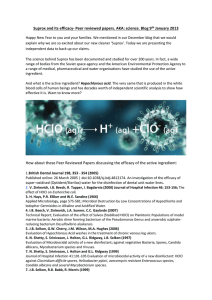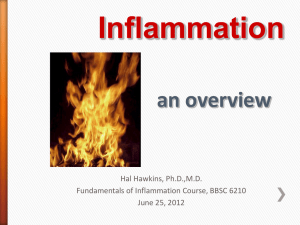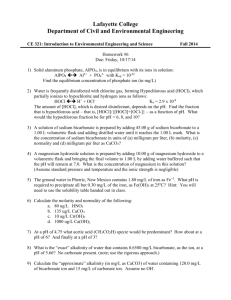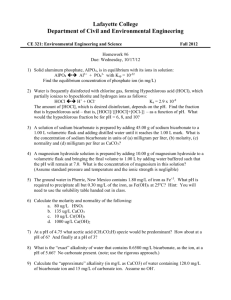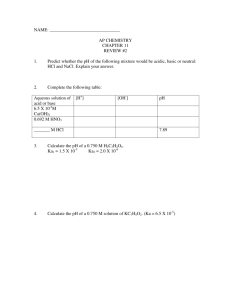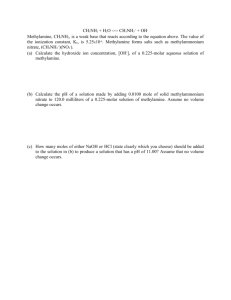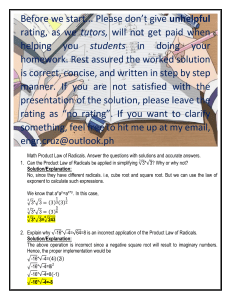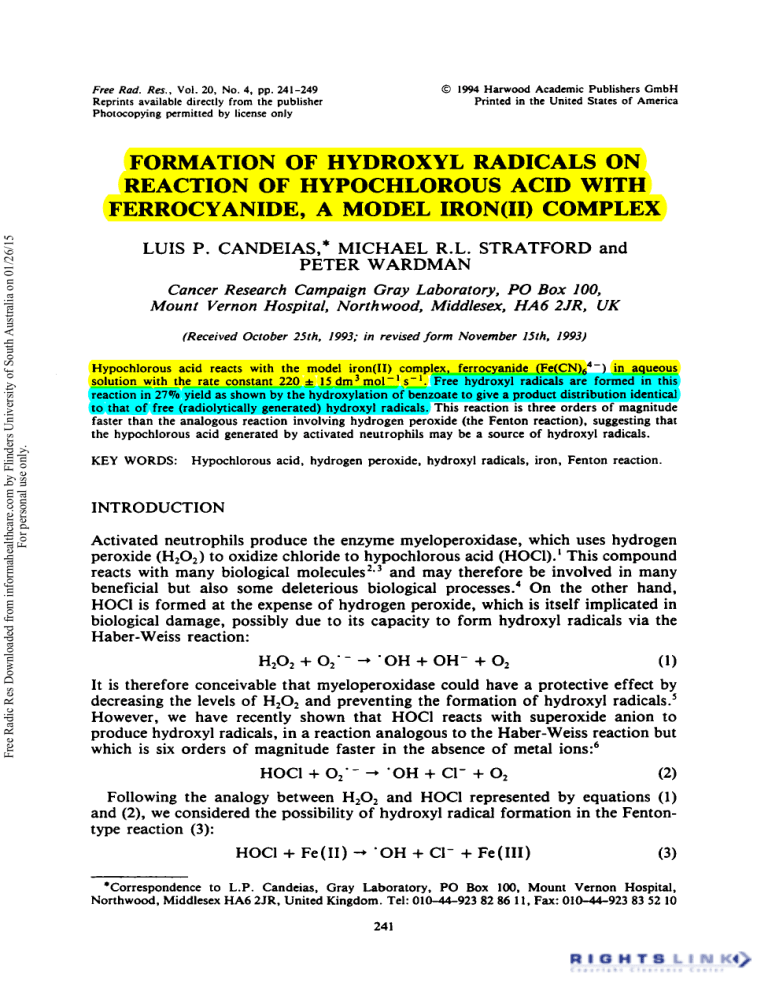
0 1994 Hawood Academic Publishers GmbH Printed in the United States of America Free Rod. Res., Vol. 20, No. 4, pp. 241-249 Reprints available directly from the publisher Photocopying permitted by license only Free Radic Res Downloaded from informahealthcare.com by Flinders University of South Australia on 01/26/15 For personal use only. FORMATION OF HYDROXYL RADICALS ON REACTION OF HYPOCHLOROUS ACID WITH FERROCYANIDE, A MODEL IRON(I1) COMPLEX LUIS P. CANDEIAS,* MICHAEL R.L. STRATFORD and PETER WARDMAN Cancer Research Campaign Gray Laboratory, PO Box 100, Mount Vernon Hospital, Northwood, Middlesex, HA6 2JR, UK (Received October 25th. 1993; in revised form November ISth, 1993) Hypochlorous acid reacts with the model iron(1I) complex, ferrocyanide (Fe(CN):-) in aqueous solution with the rate constant 220 f IS dm3 mol-' s-I. Free hydroxyl radicals are formed in this reaction in 27% yield as shown by the hydroxylation of benzoate to give a product distribution identical to that of free (radiolytically generated) hydroxyl radicals. This reaction is three orders of magnitude faster than the analogous reaction involving hydrogen peroxide (the Fenton reaction). suggesting that the hypochlorous acid generated by activated neutrophils may be a source of hydroxyl radicals. KEY WORDS: Hypochlorous acid, hydrogen peroxide, hydroxyl radicals, iron, Fenton reaction. INTRODUCTION Activated neutrophils produce the enzyme myeloperoxidase, which uses hydrogen peroxide (H202)to oxidize chloride to hypochlorous acid (HOCl).' This compound reacts with many biological molecule^^*^ and may therefore be involved in many beneficial but also some deleterious biological processes.' On the other hand, HOCl is formed at the expense of hydrogen peroxide, which is itself implicated in biological damage, possibly due to its capacity to form hydroxyl radicals via the Haber-Weiss reaction: H202+ 02.---* 'OH + OH- + O2 (1) It is therefore conceivable that myeloperoxidase could have a protective effect by and preventing the formation of hydroxyl radicals.' decreasing the levels of H202 However, we have recently shown that HOCl reacts with superoxide anion to produce hydroxyl radicals, in a reaction analogous to the Haber-Weiss reaction but which is six orders of magnitude faster in the absence of metal ions? HOCl + 02*- 'OH + C1- + 0, (2) Following the analogy between H202 and HOCl represented by equations (1) and (2), we considered the possibility of hydroxyl radical formation in the Fentontype reaction (3): HOCl + Fe(I1) + -+ 'OH + CI- + Fe(II1) (3) *Correspondence to L.P. Candeias, Gray Laboratory, PO Box 100. Mount Vernon Hospital, Northwood, Middlesex HA6 2JR, United Kingdom. Tel: 010-44-923 82 86 11, Fax: 010-44-923 83 52 10 24 1 Free Radic Res Downloaded from informahealthcare.com by Flinders University of South Australia on 01/26/15 For personal use only. 242 L.P. CANDEIAS ET AL. Since catalytically active metal ions, especially iron, may be present in biological reaction (3) can contribute to the effects of phagocytic cells. In this exploratory study we used as model compounds the hexacyano complexes of iron, ferrocyanide Fe(CN),4- and ferricyanide Fe(CN)d-. These complexes have several advantages over more biologically relevant forms of iron: both Fe(I1) and Fe(II1) forms are soluble over wide pH ranges, their absorption spectra are markedly different, the reduction potential of Fe(CN)d- is well known (Eo= 0.36 V vs NHE), and the ferrous form is relatively unreactive and can be kept in aerated solution for some time (at least one hour) before oxidation is noticeable. Ferrocyanide is known to reduce hypochiorous acid,'.' but the products of the reaction have not been identified. In the present work we have used the hydroxylation of benzoate to quantify the formation of hydroxyl radical in reaction (3). MATERIALS AND METHODS Solutions of hypochlorous acid (1-10 mmol dm-') were prepared by diluting sodium hypochlorite solutions (Aldrich) in 10 mmol dm-3 phosphate buffer at pH 7. The concentration was determined by measuring the absorption at 254 nm (the isobestic point of the spectra of HOCl and OC1-) and using ~ 2 5 4",,, = 56 dm' mol-l cm-'." These solutions (protected from light) were stable for > 2 h. Hydrogen peroxide (100 volumes), potassium salts of ferrocyanide and ferricyanide, benzoic acid and hydroxylated derivatives, L-ascorbic acid and phosphate buffers were from Merck and of analytical grade. The H202content of the commercial solutions was verified by the triiodide assay." Fresh solutions were prepared in water purified by a MilliQ system (Millipore). Kinetic measurements were performed with a Hewlett-Packard 8452A diodearray spectrophotometer. Solutions were mixed in 1 x 1 cm quartz cells stirred magnetically under conditions such that the mixing time was 1 s. Formation of Fe(CN)d- was monitored at 420nm and the yields calculated using &",,, = 1020 dm' mol-' cm-I, or for better signal to noise ratio by averaging the absorption in the range 410-430nm. Fluorescence was measured with a Perkin Elmer LS5OB luminescence spectrometer. Formation of salicylate was monitored by its fluorescence (Lx= 305 nm, A,,,, = 410nm) in stirred solutions in quartz cells in the spectrometer. In order to avoid photolysis of the solution by the excitation light, the spectrometer was programmed to take readings at fixed time intervals and to cut off the excitation light between readings. Non-linear-least-squares fits to the data were performed using Origin (MicroCal, Northampton MA, USA) weighed by the standard error of replicate measurements when appropriate. Formation of 0- (salicylate), m- and g-hydroxybenzoate from benzoate was quantified by HPLC using a Hichrom RPB column (100 x 4.6mm) with detection by UV absorption (229 and 254 nm) and fluorescence ( Lx= 295 nm, he,, = 410 nm). Elution was achieved with a linear gradient (20% to 50% in 5min) of 75% acetonitrile in water against 0.02 mol dm-' H3P0, and 0.02mol dm-' KH2P04. Ionizing radiation (y-radiation) was from a '%o source with an activity of lo00 Ci. Solutions were placed in 50 ml glass syringes at a distance of the source such that they received a radiation dose of 8. I f 0.1 Gy min-I, as determined by Fricke dosimetry.I2 All the measurements were performed at room temperature (20 f l°C). - - REACTION OF HOCl WITH FERROCYANIDE 243 RESULTS Free Radic Res Downloaded from informahealthcare.com by Flinders University of South Australia on 01/26/15 For personal use only. Rate of Reaction of Ferrocyanide with Hypochlorous Acid Solutions of potassium ferrocyanide (K,Fe(CN),) in phosphate buffer (10 mmol dm-’ at pH7.0) are colourless, but on addition of hypochlorous acid (HOCI) they rapidly became yellow. The absorption spectrum of the final mixture had a maximum at 420 nm, characteristic of the ferricyanide anion (Fe(CN)d-). With 0.1 mmol dm-3 K,Fe(CN), and excess HOCl (0.35 to 1 mmol dm-’) the absorption at 420 nm increased exponentially, i.e. followed pseudo-first order kinetics (inset of Figure 1). The pseudo-first order rate constant kobs was proportional to the concentration of HOCl (Figure l), showing that the reaction is also first order in HOCl. From the slope of the plot of /robs against the concentration of HOCl, the second order rate constant for the reaction was determined: k = 129 f 7 dm’ mol-Is-’. The yield of Fe(CN)d-, determined from the absorption at 420nm on completion of the reaction, was 99 f 4% relative to the initial concentration of Fe(CN):and independent of the concentration of HOCl, when the latter was present in excess. Under conditions of excess ferrocyanide the reaction did not follow simple first order kinetics, in agreement with previous observations.* Similar experiments were performed in which hydrogen peroxide (H202)was used instead of HOCl. It was observed that the concentration of H20, necessary to form ferricyanide in the time-scale of seconds was in the molar range, in agreement with the observations reported in the literature.” At pH 7 hypochlorous acid ( p K , = 7.6)” exists as an equilibrium mixture of HOCl and OC1- (hypochlorite). In order to determine which of these species is responsible for the oxidation of ferrocyanide to ferricyanide, we measured the rate + 010 0 n 0 nn 00 m 0 20 10 30 40 50 time I seconds 0.05 ’ 0.00 0.00 I I I 0.25 0.50 0.75 1.oo [HOCI] / mmol dm-3 FIGURE I Pseudo-first order rate (kobs) for the reaction of hypochlorous acid with ferrocyanide (0.I mmol dm’) in 10 mmol dm-’ phosphate buffer at pH 7.0. Inset: Increase of absorption observed in the presence of O.% mmol dm-3 HOCI. L.P. CANDEIAS ET AL. 244 250 Free Radic Res Downloaded from informahealthcare.com by Flinders University of South Australia on 01/26/15 For personal use only. I 5 I 6 7 8 9 PH FIGURE 2 pH dependence of the rate constant for the reaction of hypochlorousacid with ferrocyanide in 10 rnrnol drn-' phosphate buffer. The line is the weighed non-linear least squares fit to a p K curve. of the reaction at a function of pH (Figure 2). The rate of ferricyanide formation decreased with increasing pH in the range 5 to 9, from which we conclude that HOCl reacts with Fe(CN);- faster that its conjugate base OC1-. Fitting to the appropriate function for a pH-dependent reaction assuming a single pKa (using nonlinear least squares) revealed an inflection point at pH = 7.0 f 0.2, close to the reported pKa of hypochlorous acid (7.6)." The rate constants for the reaction of HOCl and OC1- obtained from the fit (solid line) were k,, = 220 f 15 and -,k = 15 f 13 dm3mol-'s-' respectively. The value of km,- is not significantly different from zero but literature data are available* from which the rate constant for the reaction of hypochlorite with ferrocyanide at pH 9.45 can be estimated as k = 0.0936 f O.OOO4. However, on the basis of kH,/ = 220 dm3mol-ls-', even = 0, we would predict an apparent rate constant at pH 9.45 of assuming -,k 1 dm3mol-l s-I. Hydroxylation of Benzoate by Hypochlorous Acid and Ferrocyanide When the reaction of ferrocyanide (0.1 mmol dm-j) with hypochlorous acid (up to 50pmol dm-3 in 10 mmol dm-' phosphate at pH 6.9) was carried out in the presence of 5 mmol dm-' benzoate, salicylate was formed, as shown by the development of fluorescence (bx= 305 nm, &, = 410 nm). No formation of salicylate was detected in the absence of either hypochlorous acid or ferrocyanide. The yield of salicylate was determined by measuring the fluorescence of the solutions after addition of variable concentrations of hypochlorous acid. The concentration of salicylate was proportional to the concentration of hypochlorous acid (up to REACTION OF HOCl WITH FERROCYANIDE 245 50 pmol dm-’); the yield of salicylate determined from the slope of the linear dependence was 6.2 0.1%. Formation of salicylate was also observed under conditions of excess hypochlorous acid, but the slow reaction of HOCl with salicylate precluded the accurate determination of the yield. HPLC analysis of the solution of benzoate and ferrocyanide (0.1 mmol dm-’) and to which HOCl 50 pmol dm-’ was added, showed that m- and p-hydroxybenzoate were also formed and that the isomeric distribution (orfho:mefa :para) was 2.0 f 0.1 : 1.1 f 0.1 : 1. No other retained peaks were observed in the HPLC elution. The hydroxylation of benzoate is suggestive of the formation of hydroxyl radicals (’OH)14on reaction of ferrocyanide with hypochlorous acid. To test this, we compared the product distribution with that obtained when free hydroxyl radicals were generated by ionizing radiation. The product distribution is affected by the reaction conditions,14 due to often incomplete conversion of the intermediate hydroxycyclohexadienyl radicals to hydroxylated products.’s Therefore we irradiated solutions identical to those used in the HOCl ferrocyanide experiments, i.e. containing 5 mmol dm-’ benzoate and 0.1 mmol dm-’ Fe(CN),4-, but without HOCl. Under these conditions, salicylate was formed with yield 23 f 1% relative to the hydroxyl radicals generated by the irradiation. The isomeric distribution was 1.8 f 0.1 : 1.1 f 0.1 : 1 of o- : m- :p-hydroxybenzoate, similar to that obtained in the HOCl + ferrocyanide experiment, showing that free hydroxyl radicals are formed also in the latter case. On the basis of the yield of salicylate on the reaction of ’OH with benzoate (23%) and on the reaction of HOCl with ferrocyanide (6.2%) the yield of hydroxyl radicals formed on reaction of HOCl with ferrocyanide can be estimated as 6.2%/23% = 27%. Free Radic Res Downloaded from informahealthcare.com by Flinders University of South Australia on 01/26/15 For personal use only. * + Hydroxylafion of Benzoare by HOCI/Ferricyanide/Ascorbate The incubation of hydrogen peroxide with iron(II1) (usually in the form of the EDTA complex) and ascorbate is a common method to generate hydroxyl radicals (or species with similar reactivity).16We tested the ability of ferricyanide to undergo similar reactions by incubating H202(1 mmol dm-’) with ferricyanide (0.1 mmol dm-’) and ascorbate (0.1 mmol dm-’) in the presence of benzoate (5 mmol dm-’ in 10 mmol dm-’ phosphate at pH 6.9). A time-dependent increase of fluorescence was observed (Figure 3), showing the hydroxylation of benzoate to salicylate. After 12 min incubation the concentration of salicylate reached a maximum at 2.6 pmol dm-’. The reaction mixture incubated for ca. 15min was analyzed by HPLC, showing the formation of hydroxylated derivatives of benzoate in the proportions 1.6 f 0.1 : 1.3 f 0.1 : 1 (orfho: mefa :para). The same experiment was repeated but replacing Hz02 by hypochlorous acid. Formation of salicylate was also observed but its formation was much faster that in the hydrogen peroxide system: the maximum yield, reached after ca. 2 min was 2.5 pmol dm-’ of salicylate and after ca. 6 min the fluorescence started to decrease (Figure 3). probably due to further reaction of salycilate with HOCl. In a reaction mixture incubated for 3 min salicylate was largely predominant over m- and p hydroxybenzoate(concentration ratio 12.0 f 0.1 :2.9 f 0.1 : 1, orfho :mefa :para). At least four other secondary products were formed in this system. L.P. CANDEIAS ET AL. 246 -/ Free Radic Res Downloaded from informahealthcare.com by Flinders University of South Australia on 01/26/15 For personal use only. 3.0 HOCl H,O, -0- -0I 0 1 -/ I 2 3 4 8 12 16 time / minutes FIGURE 3 Formation of salicylate (measured by fluorescence) in a solution of 5 mmol dm-3 benzoate, 0.1 mmol dm-3 ferricyanide. 0. I mmol dm-3 ascorbate and 1 mmol dm-j of hydrogen peroxide (open symbols) or hypochlorous acid (solid symbols). DISCUSSION We have shown that hypochlorous acid oxidizes ferrocyanide to ferricyanide with rate constant k = 220 f 15 dm-' mol-l s-I. The conjugate base of hypochlorous acid, the hypochlorite anion, is a much weaker oxidant and therefore the rate of oxidation of ferrocyanide by equilibrium mixtures of hypochlorous acid and hypochlorite decreases with increasing pH in the range 5 to 9. At pH 7.0 the rate constant is 129 f 7 dm'mol-l s-I. Hypochlorous acid and ferrocyanide hydroxylate benzoate to o-,m- and phydroxybenzoate, in an isomeric distribution which is very similar to that produced by radiolytically-generated hydroxyl radicals ( * OH) under comparable conditions. Singlet oxygen can also hydroxylate aromatic compounds, but leading to a distribution of isomers different of that produced by hydroxyl radical^."^^^ Therefore, the similar isomer distribution obtained with HOCl + ferrocyanide and by radiolysis lead to the conclusion that 'OH is formed on reaction of hypochlorous acid with ferrocyanide: Fe(CN),4- + HOCl + Fe(CN),'- + C1- + 'OH (4) Formally, the one-electron reduction of hypochlorous acid can yield either hydroxyl radicals or chlorine atoms: + eHOCl + e- HOCl -+ + 'OH + C1- (5) OH- + CI' ( 6) Free Radic Res Downloaded from informahealthcare.com by Flinders University of South Australia on 01/26/15 For personal use only. REACTION OF HOCl WITH FERROCYANIDE 241 Both redox semi-equations have positive Gibbs free energy change at 298 K of semi= -FAEo), as calculated from literature data," but equation ( 5 ) (3.9 kJ mol-') is lower than that of semi-equation (6) (124.5 kJ mol-'). Therefore, the formation of 'OH on one-electron reduction of HOCl is thermodynamically favoured over the formation of C1' . The primary product of the outer-sphere one-electron reduction of HOCl is the radical anion HOC1'-; this species is also formed on the reaction of hydroxyl radical with chloride anion (k = 4.3 x 1O9dm3mol-'s - ' ) : ~ 'OH + C1- HOC1'(7) Pulse radiolysis studiesMhave shown that this reaction is reversible (K = 0.7). It can thus be predicted that, in the absence of chloride, HOC1'- decomposes into 'OH and Cl- with rate constant k = 6.1 x 10'dm3m01-'s-'. HOC1'- can also decay into C1' and OH- but at p H 7 the rate constant for this rection is only 2100dm3mol-'s-'.20 On the basis of these kinetic arguments it can be predicted that in neutral solution and in the absence of chloride the products of the outersphere one-electron reduction of HOCl are 'OH and C1- (eqn. 5). However, our results show that the yield of hydroxyl radicals on reaction of hypochlorous acid with ferrocyanide is only 27%; we conclude that alternative parallel reaction mechanisms are effective. Inner-sphere electron transfer is a possible mechanism and the involvement of an intermediate with life-time in the millisecond range supports this hypothesis.' The two-electron oxidation of HOCl is thermodynamically more favourable (AGO, = -46 kJ mol-I) than the oneelectron reaction and the oxidation of ferrocyanide could, in principle be a twoelectron process forming the iron(1V) complex Fe(CN);-. We found no evidence for such a complex, either in the absorption spectra or in the benzoate hydroxylation experiments. The reaction of ferrocyanide with hypochlorous acid generating hydroxyl radicals (eqn.4) is analogous to the Fenton-type reaction (8): Fe(CN),4- + H202 -+ Fe(CN);- + OH- + 'OH (8) However, the rate of reaction (8) at pH 7 is only 0.22 dm3mol-' s-',I3 three orders of magnitude lower than the rate constant for the HOC1-analogous reaction (4). The ascorbate/ferricyanide system provides a further comparison between hypochlorous acid and hydrogen peroxide. Both systems induced hydroxylation of benzoate, although the product distributions were distinct, and in either case different from the 'OH fingerprint. It is not clear at this stage if this reflects formation of reactive species other than free hydroxyl radicals or if reactions of the intermediate hydroxycyclohexadienyl radicals affect the isomer distribution. Also additional products were formed in the HOCl system, which could be the result of further oxidation of the hydroxylated benzoates with HOCl. Nevertheless, it is clear that hypochlorous acid induced hydroxylation of benzoate much faster than hydrogen peroxide. CONCLUSIONS We have shown that hypochlorous acid is able to participate in reactions similar to those usually invoked to explain the biological effects of hydrogen peroxide: the formation of hydroxyl radicals on reaction with superoxide6 (Haber-Weiss L.P. CANDEIAS ET AL. Free Radic Res Downloaded from informahealthcare.com by Flinders University of South Australia on 01/26/15 For personal use only. 248 reaction) or with iron(I1) (Fenton reaction), although in the latter case the formation of ’OH is not quantitative. Furthermore, the rate constants for the HOCl reactions are six or three orders of magnitude higher than the H,O, reactions, for the Haber-Weiss or the Fenton-type reactions, respectively. It is presently not known if the hexacyano complexes of iron used in this study are representative of the biologically relevant forms of iron. However, our results suggest that in activated neutrophils, hypochlorous acid, rather than hydrogen peroxide, could be the oxidant reacting with superoxide and/or metal ions to generate hydroxyl radicals. The enzyme myeloperoxidase converts H,O, into HOCl and can therefore determine which of the pathways prevails. The influence of antioxidants and other biological molecules in this balance must also be ons side red.^'-^^ Hypochlorous acid reacts with amino and thiol groups,’ although absolute rate constants are lacking. On the other hand, the concentration of H,O, is limited enzymatically by catalase and peroxidases (including myeloperoxidase), whereas similar pathways for the decay of HOCl are not known. Acknowledgments This work was supported by the Cancer Research Campaign. The assistance of Mr. K.B. Patel, Mrs. L.K.D. Folkes and Ms. M. Easton in some of the experiments is gratefully acknowledged. References 1. A.J. Jesaitis and E.A. Dratz eds. (1992) The Molecular Basis of Oxidative Damage by Leukocytes. CRC Press, Boca Raton. 2. J.M. Albrich, C.A. McCarthy and J.K. Hurst (1981) Biological reactivity of hypochlorous acid: 3. 4. 5. 6. 7. 8. 9. 10. 11. 12. 13. implications for microbicidal mechanisms of leukocyte myeloperoxidase. Proceedings of rhe National Academy of Sciences USA, 78, 210-214. C.C. Winterbourn (1985) Comparative reactivities of various biological compounds with myeloperoxidase-hydrogen peroxide-chloride, and similarity of the oxidant to hypochlorite. Biochimica el Biophysics Acra, 840, 204-210. B. Halliwell and J.M.C. Gutteridge (1989) Free Radicals in Biology and Medicine. 2nd edn, Claredon Press, Oxford. C.C. Winterbourn (1986) Myeloperoxidase as an effective inhibitor of hydroxyl radical production. Journal of Clinical Investigation, 78. 545-550. L.P. Candeias, K.B. Pate!, M.R.L. Stratford and P. Wardman (1993) Free hydroxyl radicals are formed on reaction between the neutrophil-derived species superoxide anion and hypochlorous acid. FEBS Letters, 333, 151-153. J.M.C. Gutteridge, B. Halliwell and D.R. Rowley (1985) The involvement of iron, copper and oxygen radicals in human diseases. Life Chemistry Reports, 3, 232-243. L. Hin-Fat (1988) Kinetics of the reaction between hypochlorous acid and hexacyanoferrate(I1) ion in aqueous solution. Journal of the Chemical Society, Dalton Transactions, 273-215. Y.N. Kozlov, T.P. Vorob’eva and A.P. Purmal (1981) The elementary steps in the oxidation of titanium(II1) ethylenediaminetetraacetate and of hexacyanoferrate(I1) with hypochlorous acid. Russian Journal of Physical Chemistry, 55, 1294-1297. J.C. Morris (1966) The acid ionization constant of HClO from 5 to 3 5 O C . Journal of Physical Chemistry, 70, 3798-3805. J.M. Gebicki and J. Guille (1989) An improved assay for hydroperoxides. In Medical, Biochemical and Chemical Apects of Free Radicals. vol. 2 (eds. 0 . Hayashi, E. Niki, M. Kondo and T. Yoshikawa), Elsevier. Amsterdam, pp. 913-917. Y. Tabata, Y. Ito and S. Tagawa eds. (1991) Handbook of Radiation Chemistry. CRC Press, Boca Raton. K.K. Girdhar (1978) Spectrophotometrical studies of the kinetics of the conversion of ferrocyanide to ferricyanide in the presence of hydrogen peroxide. Revue Roumaine de Chimie. 23, 819-824. Free Radic Res Downloaded from informahealthcare.com by Flinders University of South Australia on 01/26/15 For personal use only. REACTION OF HOCl WITH FERROCYANIDE 249 14. B. Halliwell, M. Grootveld and J.M.C. Gutteridge (1989) Methods for the measurement of hydroxyl radicals in biochemical systems: deoxyribose degradation and aromatic hydroxylation. Methods of Biochemical Analysis, 33, 59-90, IS. G.W. Klein, K. Bhatia. V. Madhavan and R.H. Schuler (1975) Reaction of 'OH with benzoic acid. Isomer distribution in the radical intermediates. Journal of Physical Chemisfry, 79, 1767-1774. 16. B. Halliwell and J.M.C. Gutteridge (1992) Biologically relevant metal ion-dependent hydroxyl radical generation. F€BS Leffers,307, 108-1 12. 17. K. Briviba, T.P.A. Devasagayam, H. Sies and S. Steenken (1993) Selective para hydroxylation of phenol and aniline by singlet molecular oxygen. Chemical Research in Toxicology, 6 , 548-553. 18. B. Kalyanaraman, S. Ramanujam, R.J. Singh, J. Joseph and J.B. Feix (1993) Formation of 2.5-dihydroxybenzoic acid during the reaction between '0, and salicylic acid: analysis by ESR oximetry and HPLC with electrochemical detection. Journal of the American Chemical Sociefy, 115, 4007-4012. 19. W.H. Koppenol and J. Butler (1985) Energetics of interconversion reactions of oxyradicals. Advances in Free Radical Biology & Medicine, 1, 9 1- 13 I . 20. G.G. Jayson, B.J. Parsons and A.J. Swallow (1973) Some simple, highly reactive. inorganic chlorine derivatives in aqueous solution. Journal of fhe Chemical Society. Faraday Transactions,69, 15971607. 21. M. Grootveld, B. Halliwell and C.P. Moorhouse (1987) Action of uric acid, allopurinol and oxypurinol on the myeloperoxidase-derived oxidant hypochlorous acid. Free Rudical Research Communications. 4, 69-76. 22. B. Halliwell, M. Wasil and M. Grootveld (1987) Biologically significant scavenging of the myeloperoxidase-derived oxidant hypochlorous acid by ascorbic acid. F€BS Leffers,213, 15-18. 23. M. Paya, B. Halliwell and J.R.S. Hoult (1992) Interactions of a series of cournarins with reactive oxygen species. Scavenging of superoxide, hypochlorous acid and hydroxyl radicals. Biochemical Pharmacology, 44,205-214. Accepted by Professor B. Halliwell
